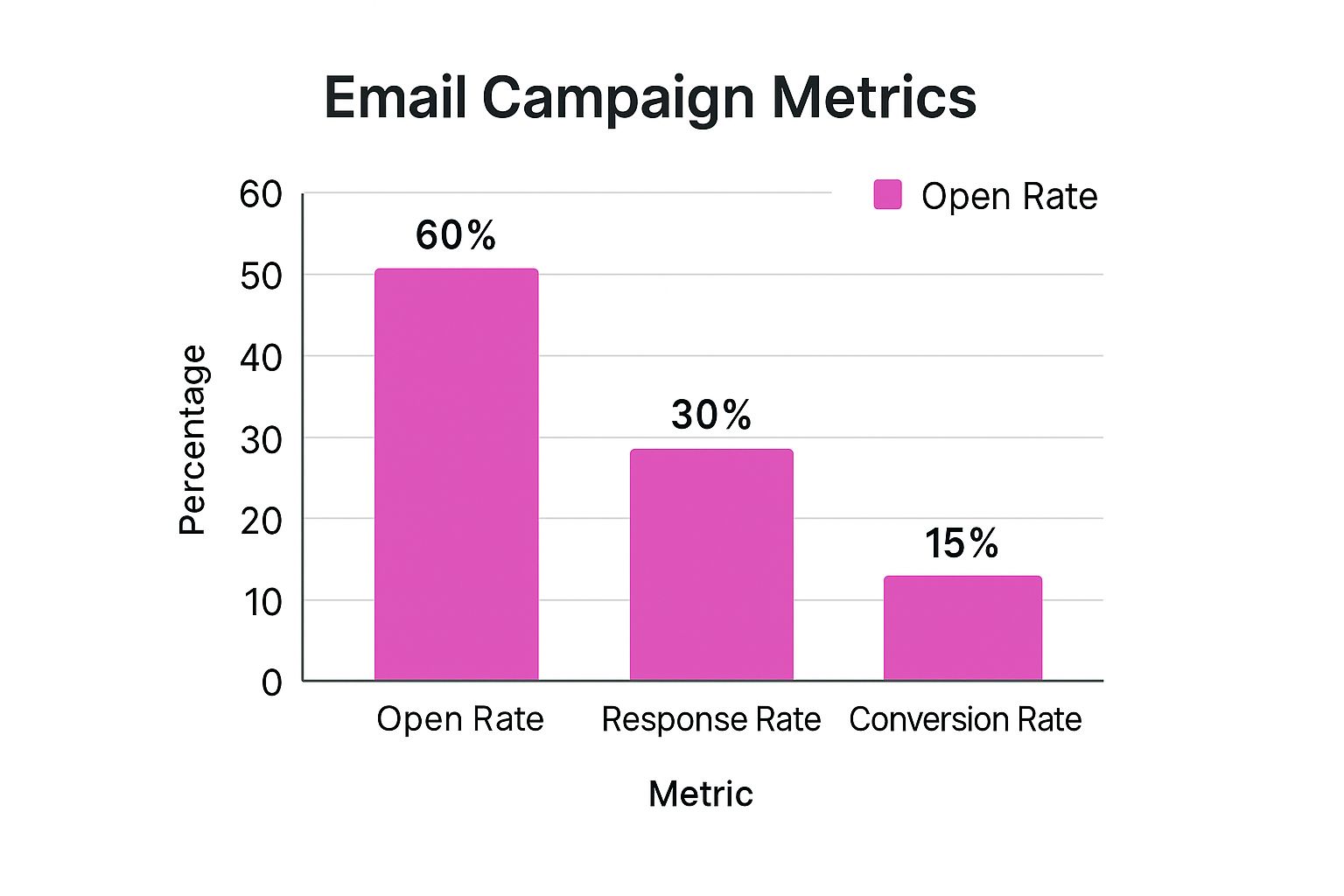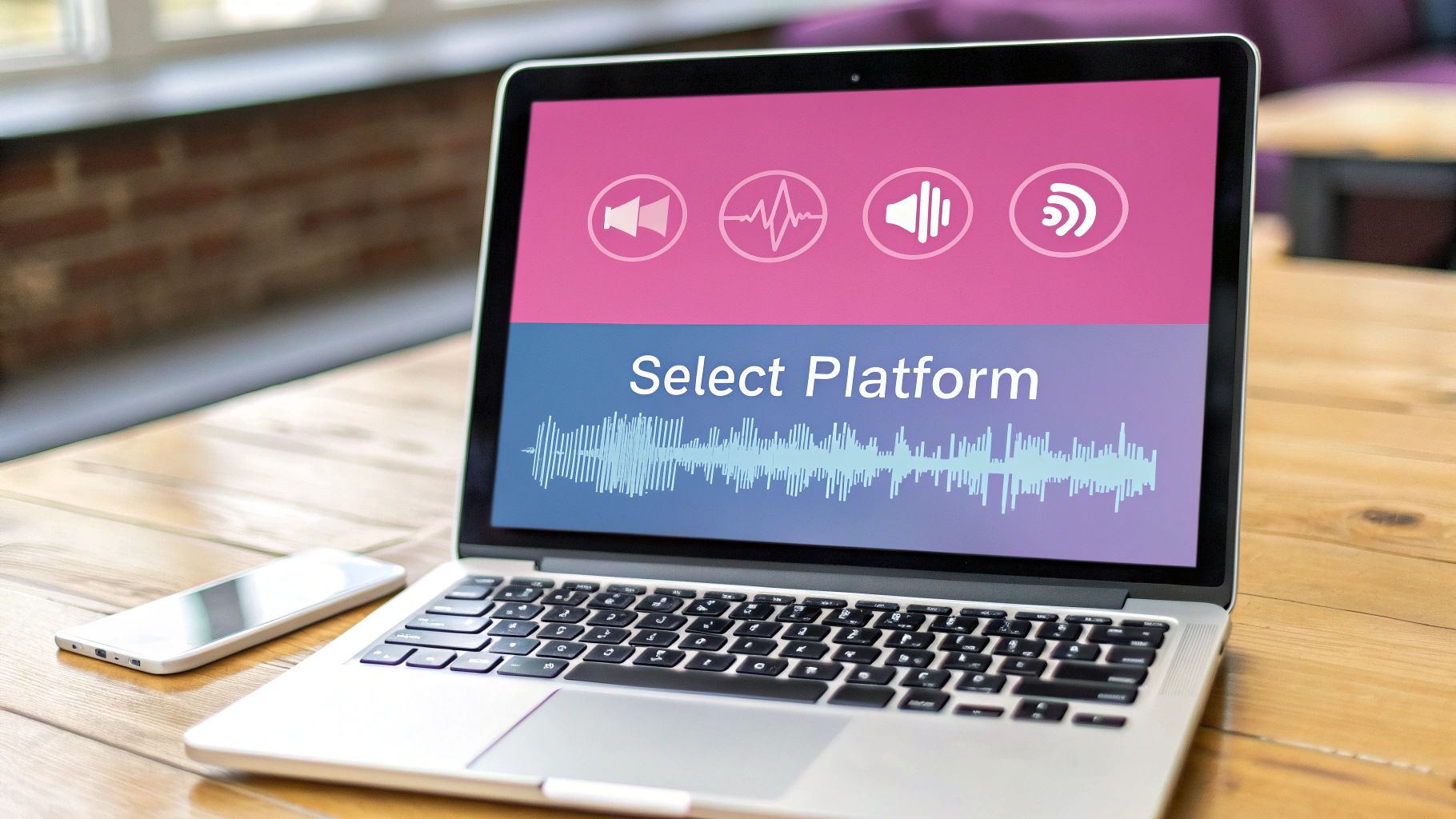Using Personalized Voice Messages to Boost Engagement
Personalized voice messages are audio messages sent to a specific person, but with a twist. They’re dynamically updated with details like their name or appointment time, making each message feel unique. Unlike those generic robocalls we all hate, this approach uses AI to create a powerful one-to-one connection at scale, making every single person feel like you recorded that message just for them.
What Exactly Are Personalized Voice Messages?

Think about sorting through your mail. Most of it is junk, addressed to "Current Resident," and it goes straight into the recycling bin. But then you spot a handwritten letter with your name on it. Which one are you going to open?
Personalized voice messages work the same way in the digital world. They're the complete opposite of the one-size-fits-all robocalls that people have trained themselves to ignore. Instead of a bland, pre-recorded script, these are highly specific audio messages that speak directly to an individual.
The Power of Dynamic Content
The real magic here is how a single core recording can be automatically updated for every person on your list. With modern AI, key details are slipped seamlessly into the audio, turning what would be a mass broadcast into something that feels like a personal call.
This personalization can include all sorts of data points, like:
- First Name: A simple "Hi, Sarah" is so much more engaging than a generic greeting.
- Order Number: Confirming a specific order makes the message instantly relevant.
- Appointment Time: Giving a precise date and time helps slash no-shows.
- Product or Service Mention: Referencing something they recently bought or looked at builds a sense of continuity.
This method creates a genuine one-to-one connection, even when you're reaching out to thousands of people at once. It makes the listener feel seen and valued in a way that generic texts or emails just can't match. By speaking to them as an individual, you cut through the marketing noise and make your message stick.
You can learn more about the bigger picture in our guide to automated voice messages, which breaks down how automation and personalization can work together.
Beyond Robocalls: A Human-Centric Approach
It’s really important to draw a clear line between personalized voice messages and the intrusive spam calls that plague our phones. The goal isn't to interrupt or annoy. It's about delivering timely, relevant, and helpful information in a much more human format.
Hearing a friendly, natural-sounding voice is a fundamentally different experience than reading a block of text.
A study found that voice messages can feel more personal and lead to higher engagement because the human voice conveys tone and emotion, elements that are completely lost in text-based communication.
This human touch is especially powerful for getting around "phone anxiety," where people are hesitant to answer calls from unknown numbers. By delivering a clear, personal, and valuable message directly to their voicemail, you provide information without demanding a high-pressure, immediate interaction. It's a method that respects the recipient's time while making sure your message actually gets heard.
Why Voice Messages Are Your Secret Weapon

We live in a world of unread notifications. Think about your own phone for a second—how many unread emails, texts, or social media DMs are just sitting there? Now, how often do you let a voicemail go unheard?
Probably not very often.
Hearing a human-like voice just feels different—it’s more personal, more urgent, and it breaks through the noise. This simple fact is why personalized voice messages are becoming a secret weapon for businesses trying to get heard. They grab attention in a way flat text just can't.
This isn't just about getting noticed; it’s about getting a response. Emails land in spam folders and texts get swiped away, but a well-crafted voice message feels like a direct, one-to-one conversation.
Boosting Engagement and Building Trust
The real magic of voice is its ability to carry tone, emotion, and sincerity. These are the things that build trust, and they're completely lost in standard text-based messages. Think about it: a warm, friendly voice confirming an order or reminding a client about their appointment feels helpful, not pushy.
That human touch translates directly into better engagement. When a message feels personal, people are far more likely to do what you're asking, whether that’s clicking a link, confirming a time, or calling you back.
"A personalized voice message creates a moment of genuine human connection. It reminds the customer that there's a real person on the other side, which fosters loyalty and dramatically increases response rates."
By shifting a transactional notification into a relational interaction, you start building a stronger, more resilient customer relationship. It’s a small change in your method that delivers a huge shift in perception.
Unlocking Efficiency at Scale
Okay, the idea of sending thousands of unique voice messages sounds like a logistical nightmare, right? In the past, you'd have needed a massive team and countless hours glued to a phone. But modern platforms have completely changed the game.
Now, you can send thousands of personalized voice messages without any manual work. You can take a single pre-recorded template and have it dynamically filled with customer-specific details like names, appointment times, or order numbers.
This blend of personalization and automation is incredibly efficient. Early adopters have found that campaigns combining personalized voice messages with SMS see engagement rates jump by 40% compared to SMS-only campaigns. If you want to dive deeper, you can explore more data on how voice AI is shaping market trends to see its growing influence.
This means you can get far better results from your outreach while saving a ton of time and resources. It's the perfect mix of high-tech efficiency and high-touch communication, giving your messages the impact they deserve.
Putting Personalized Voice Messages Into Action
Theory is one thing, but seeing personalized voice messages in action is where you really get it. These aren't just robotic notifications; they're smart, tailored messages solving real-world business problems across tons of industries. They turn a generic heads-up into a meaningful connection.
Take an e-commerce brand, for example. Instead of a sterile shipping update email, imagine a customer getting a friendly voice note: “Hi Alex, your new sneakers have just shipped and should arrive Friday!” That tiny touch makes the whole experience feel more personal, more premium.
In healthcare, the impact is even more powerful. Clinics can slash costly no-shows with a simple, human-sounding reminder. A message like, “Hi Sarah, this is a reminder of your appointment with Dr. Smith tomorrow at 10 AM,” cuts through the noise far better than a text that gets buried.
Practical Applications Across Departments
This isn't just a single-use gimmick. Different teams can use this technology to hit their specific goals. It's a versatile tool that adapts to whatever you need, from drumming up new leads to taking care of your existing customers.
Marketing and sales teams are using them to send out exclusive invites for webinars or special events. A message that says, "Hi David, as a valued customer, we're inviting you to our private product launch next week," creates a feeling of exclusivity that a mass email blast just can't touch.
Customer service teams can get ahead of problems with proactive updates. Think about getting a voice message that says, "Hi Maria, this is Kevin from support. We've resolved ticket number 5-4-3-2-1, and your account access has been restored." It keeps the customer in the loop and shows their issue got personal attention.
Even banks and financial institutions are getting in on it. They can send automated yet personalized fraud alerts that feel both urgent and trustworthy. For example: "Hi John, this is a security alert from your bank. We've detected a suspicious transaction on your card ending in 1234. Please call us back at the number on your card to verify."
This graphic gives you a clear visual breakdown of what you can expect from a typical personalized voice campaign.

As you can see, the data is pretty clear. The open rates are high, but the real magic is in getting people to take action, which is why response and conversion rates are so strong.
Every one of these examples drills down to a core idea: personalization adds value. By delivering relevant, timely, and specific info, these messages solve a business problem while making the customer relationship stronger.
To see how these different methods stack up, let's look at a quick comparison.
Comparing Communication Methods for Key Business Tasks
| Business Task | Generic Email | Standard SMS | Personalized Voice Message | | --- | --- | --- | --- | | Appointment Reminders | Easily ignored, low open rates. | Often gets lost in other texts. | High engagement, feels personal. | | Special Offer Invites | Low click-through, feels like spam. | Lacks context, feels impersonal. | Creates exclusivity, drives action. | | Order/Shipping Updates | Sterile, often lands in junk mail. | Basic info, no brand personality. | Builds excitement, feels premium. | | Fraud Alerts | Can be missed, lacks urgency. | Can be mistaken for a phishing text. | Conveys urgency and trustworthiness. | | Customer Feedback Request | Very low response rates. | Can feel intrusive and demanding. | More personal, higher response rate. |
It's pretty clear that for tasks where a personal connection matters, voice messages have a distinct advantage. They cut through the digital clutter and make a real impression.
Voice is quickly becoming a major differentiator in customer service. In fact, one big prediction is that by 2025, 50% of customer service interactions will involve emotion-sensing AI—the core tech that makes these nuanced voice messages possible. You can get a deeper dive into the future of voice marketing trends to see how this is reshaping entire industries. This shift toward more natural, voice-first communication shows just how important it is to start bringing these tools into your strategy now.
How to Create Your First Voice Campaign
Ready to jump in? Let's walk through setting up your very first personalized voice message campaign.
[Content type 'embed' not supported]
Getting started with personalized voice messages might sound intimidating, but it's surprisingly simple. If you've ever used mail merge for emails, you already know the basic concept. You’re just taking a master audio file and blending it with your contact data to create thousands of unique, personal messages on the fly.
This guide will take you through the process step-by-step, from recording your audio to hitting the launch button. My goal here is to give you a clear, actionable roadmap to connect with your audience in a way that feels genuinely human.
Step 1: Prepare Your Audio
First things first, you need the core audio for your message. You've got two main routes you can take, and the best choice really depends on your brand and what you're trying to achieve with the campaign.
- Record Your Own Voice: For that truly authentic, personal touch, nothing beats using your own voice. It adds a layer of trust and sincerity that’s hard to fake, which is gold for small businesses or anyone building a personal brand.
- Use Text-to-Speech (TTS): Don't dismiss this option! Modern AI-powered TTS engines are incredibly realistic. They can generate natural-sounding audio in different accents and tones, giving you consistency and scalability for much larger campaigns.
Whichever path you choose, remember to keep your script short, sweet, and friendly. A great voice message gets right to the point without sounding robotic. If you need a little inspiration, check out these custom voicemail greeting examples to see how to craft a script that works.
Step 2: Set Up Your Contact List
Think of your contact list as the engine that drives all the personalization. This is where you'll organize all the little details that will make each and every voice message feel unique. It’s way more than just a list of phone numbers—it's the structured database for your entire campaign.
Just start with a simple spreadsheet. Create columns for the essentials like PhoneNumber, FirstName, and LastName. Then, add any other custom details you want to pull in. For instance, an e-commerce shop might add columns for OrderNumber or LastPurchaseItem. A doctor's office could use a column for AppointmentTime.
Pro Tip: Make sure your data is clean. A tiny typo in your spreadsheet, like a misspelled name, will be read aloud in the final audio. Take a minute to double-check your list for accuracy before you upload it. It's worth it.
Step 3: Build and Personalize Your Campaign
Alright, this is where the magic happens. You're going to bring your audio and your contact list together. Using a specialized platform, you'll upload your audio file (or just type your script for the TTS to read) and start inserting personalization tags. These tags are basically placeholders that match up with the columns in your spreadsheet.
For example, your script could look something like this: "Hi [FirstName], just confirming that your order, number [OrderNumber], has officially shipped. Thanks so much for your purchase!"
The system does the heavy lifting, automatically grabbing the data for "FirstName" and "OrderNumber" from each row of your contact list. It then generates a completely unique audio file for every single person on your list.
Step 4: Schedule and Launch
The last step is simply deciding when to send your messages. You can fire them off immediately or schedule them for the perfect moment. Timing is everything here. An appointment reminder sent a week early is just noise, but one sent the day before is incredibly helpful.
Once you hit "launch," the platform takes over. It dials the numbers, delivers the personalized voice messages, and gives you real-time analytics so you can see your delivery rates and engagement. And just like that, you've launched a sophisticated, personal outreach campaign in just a few clicks.
Best Practices for High-Impact Voice Campaigns

It’s easy to create a voice message. But crafting one that actually gets results? That takes a bit of strategy. Sending personalized voice messages is about more than just hitting "send"—it’s about smart, thoughtful communication.
Follow a few of these proven tips, and you’ll make sure your campaigns aren’t just heard, but acted on.
The first rule of thumb is to respect your listener's time. Nobody has the patience for a long, rambling message. Keep it short and punchy, aiming for under 45 seconds to hold their attention from beginning to end.
This means you need to get straight to the point. Don’t bury the key details. Start with the most critical info—like a name, appointment time, or order number—to immediately show them this message is for them and worth listening to.
Crafting the Perfect Message
Once you’ve got their ear, it’s all about clarity and action. A confusing message is a deleted message, simple as that. Your script needs to be dead simple to follow, and your call-to-action (CTA) must be direct and obvious.
Your CTA should give the listener a clear next step without making them think too hard. Instead of a vague "visit our website," try something specific like, "reply to the text we just sent you" or "call us back at the number provided."
The tone of your voice is just as important as the words you say. Your vocal delivery should align with your brand's personality and the context of the message. A fraud alert requires a serious, professional tone, while a special offer can be more upbeat and friendly.
Refining Your Approach with Testing
No campaign is perfect right out of the gate. The real secret to getting a great return is to constantly tweak and test your approach. Just like marketers A/B test their emails, you should be testing different parts of your voice campaigns to see what truly connects with your audience.
Here are a few variables you should absolutely be testing:
- Script Variations: Try different opening lines, calls-to-action, or ways of phrasing things to see which version gets a better response.
- Delivery Times: Experiment with sending messages at different times of the day or days of the week. You might find your audience is way more responsive on a Tuesday morning than a Friday afternoon.
- Voice Style: If you're using a text-to-speech engine, test out different voices to find the one that best fits your brand. For those who want the ultimate personal touch, looking into AI voice cloners gives you a peek into the future of hyper-unique audio messaging.
By methodically testing these elements and digging into the data, you can turn a good campaign into a great one. This data-driven mindset lets you move past guesswork and make smart decisions that consistently boost your results and build a stronger connection with your audience.
Got Questions? We’ve Got Answers.
As you start thinking about using personalized voice messages, a few practical questions are bound to pop up. It's totally normal. This last section is dedicated to giving you clear, straightforward answers to the most common things we hear from people just like you.
We'll cover the big topics—legal stuff, voice quality, and tracking results—to help you feel confident moving forward.
Are Personalized Voice Messages Even Legal to Send?
Yes, they are, but you absolutely have to play by the rules. The biggest one in the U.S. is the TCPA (Telephone Consumer Protection Act). The main takeaway is that for marketing messages, you almost always need prior express consent from people before you send them anything automated or pre-recorded.
Now, for purely informational messages—think appointment reminders or shipping updates—the rules can be a bit different. But honestly, the best practice is always to chat with a legal expert to make sure your campaigns are fully compliant with both national and local regulations. Better safe than sorry.
Will The AI Voice Sound Robotic and Awful?
Not anymore. Today’s AI text-to-speech (TTS) technology has come an incredibly long way. Modern platforms use sophisticated AI to generate voices that are stunningly natural, with the kind of realistic pacing and intonation that’s often impossible to tell apart from a real person.
Gone are the days of monotone, robotic voices. You can now pick from a whole library of voice styles, accents, and languages to find the perfect one that fits your brand’s personality.